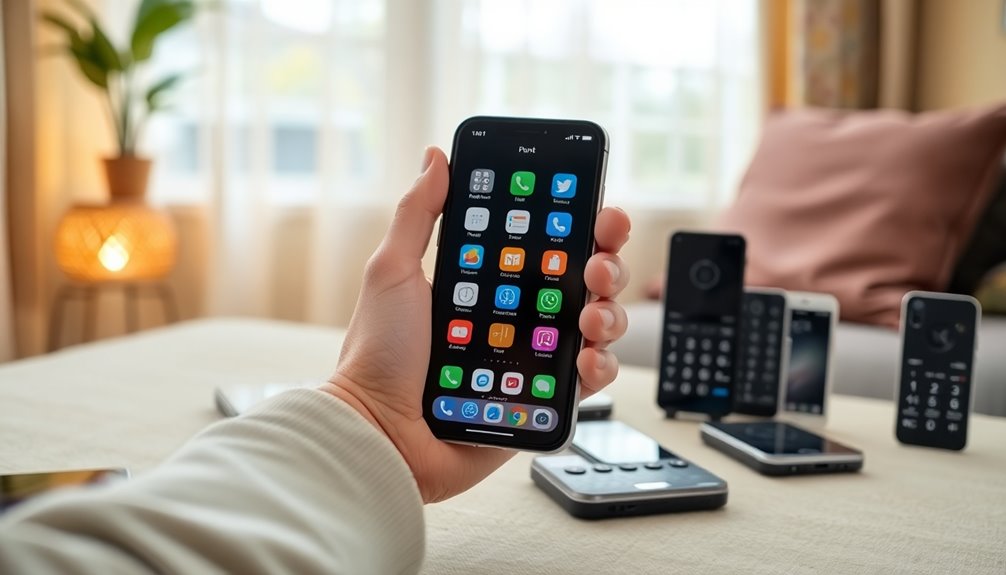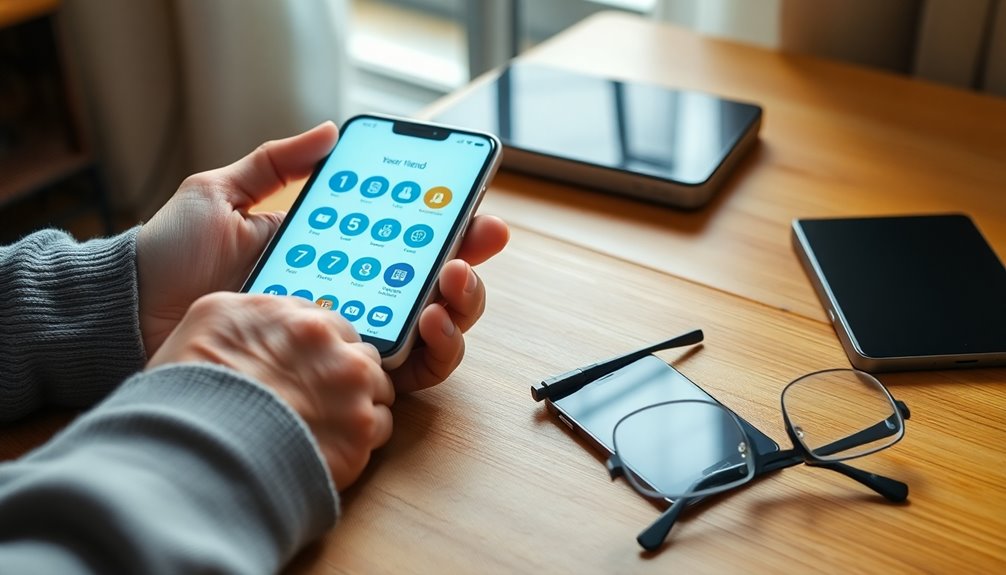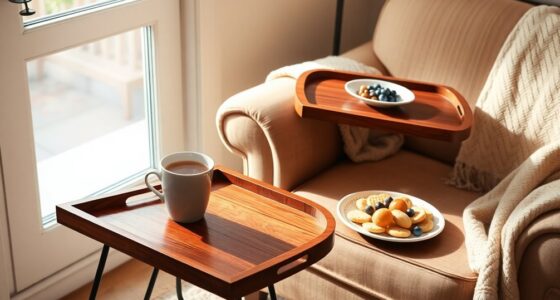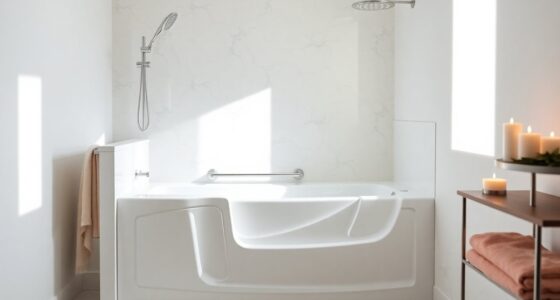When searching for easy-to-use phones for seniors, I’ve found several great options. The Serene Innovations Amplified Big Button Phone features large buttons and enhanced sound. The VTech SN5147 combines big buttons with a smart call blocker. For those needing visual aids, the SMPL Landline Big Button Phone offers photo memory keys. Each of these phones has unique benefits tailored to seniors. Stick around, and you’ll discover more about the best phones that suit their needs.
Key Takeaways
- Look for phones with large buttons and displays to enhance visibility and minimize dialing errors for seniors with visual impairments.
- Opt for devices with amplified sound features to assist seniors with hearing loss in communicating effectively.
- Consider models with photo memory keys for quick and easy dialing to loved ones, catering to seniors with memory challenges.
- Evaluate phones with smart call blocking capabilities to reduce disruptions from unwanted robocalls, improving communication reliability.
- Ensure straightforward setup and user-friendly interfaces to promote independence and ease of use for elderly users.
Serene Innovations Amplified Big Button Landline Phone for Seniors
When it comes to selecting the best phone for seniors, the Serene Innovations Amplified Big Button Landline Phone stands out, especially for those dealing with dementia or significant hearing loss. This phone features 26dB amplification and large buttons that make dialing easy, even for those with memory impairments. I love the nine programmable speed dial buttons with photo options, helping users quickly identify contacts. The loud ringer guarantees that calls are never missed, while its ability to function during power outages gives peace of mind. Overall, it’s designed for simplicity and accessibility, making it a fantastic choice for elderly users.
Best For: Seniors with dementia or significant hearing loss who require a simplified and accessible communication solution.
Pros:
- Easy-to-use design with large buttons and visual aids, ideal for users with memory or cognitive impairments.
- Amplification of up to 26dB and a loud ringer ensures calls are heard clearly, even in noisy environments.
- Programmable speed dial buttons with photo options enhance quick contact identification, promoting independence.
Cons:
- Some users report issues with static and low volume, despite adjustments.
- The programming of memory buttons can be complicated and lacks audible feedback for confirmation.
- Absence of a Caller ID feature may lead to difficulties identifying spam calls.
VTech SN5147 Amplified Corded/Cordless Senior Phone
The VTech SN5147 Amplified Corded/Cordless Senior Phone stands out as an exceptional choice for seniors, particularly those with hearing impairments. Its 50dB Audio Assist boosts volume, making conversations clearer. I love the photo dial feature, allowing me to program eight contacts with their pictures for quick recognition. The big buttons and large display make it user-friendly, while the 90dB ringer guarantees I never miss a call. Additionally, the smart call blocker keeps unwanted robocalls at bay. Overall, this phone has greatly improved my communication with family, enhancing my independence and connection.
Best For: Seniors and individuals with hearing or visual impairments who need a straightforward and reliable communication solution.
Pros:
- Loud ringing and clear sound enhance call experiences.
- Large buttons and a photo dial feature facilitate easy dialing of frequently contacted numbers.
- Smart call blocker effectively reduces unwanted robocalls.
Cons:
- The cordless phone can be confusing due to multiple buttons.
- Sound quality may vary depending on the connection.
- Battery life of cordless handsets may require frequent charging.
SMPL Landline Big Button Phone for Seniors (Model 56010)
For seniors, particularly those dealing with memory challenges, the SMPL Landline Big Button Phone (Model 56010) stands out with its innovative photo memory keys. This feature allows me to assign photos to three dedicated keys, making it easy for my loved ones to call instantly. The amplified sound guarantees I never miss a call, and the large buttons make dialing effortless. I appreciate the visual flasher that alerts me to incoming calls. While it’s easy to set up, I’ve noticed some quirks with the volume resetting. Overall, it’s a reliable option that truly caters to the needs of seniors.
Best For: Seniors and individuals with memory challenges who need an easy-to-use phone for quick dialing and enhanced sound notifications.
Pros:
- Photo memory keys enable instant dialing to loved ones, making communication effortless.
- Amplified sound ensures calls can be heard clearly, even in noisy environments.
- Large buttons simplify dialing for users with dexterity issues.
Cons:
- Handset volume resets after use, which can be confusing for users with dementia.
- Photo dialing feature may encounter issues with VoIP systems, leading to potential accidental deletions.
- Wall mount compatibility might limit installation options due to design constraints.
AT&T BL102-2 DECT 6.0 Cordless Phone with Answering Machine
Seniors seeking a reliable and user-friendly phone will appreciate the AT&T BL102-2 DECT 6.0 Cordless Phone with Answering Machine. This phone features a large 2-inch screen and lighted keypad, making it easy to read and use in low-light conditions. The smart call blocker automatically filters out unwanted calls, while the caller ID announcer helps you decide whether to answer. With an impressive 22 minutes of recording capacity, you won’t miss important messages. Although some users find the setup a bit tricky, the overall ease of use and excellent range make it a solid choice for seniors.
Best For: Seniors seeking a reliable and user-friendly phone with advanced call management features.
Pros:
- Smart call blocker effectively filters out unwanted calls.
- Large 2-inch screen and lighted keypad enhance usability for visually impaired users.
- Impressive 22 minutes of recording capacity for important messages.
Cons:
- Some users find the setup process complicated and unintuitive.
- Inconsistent performance reported with call blocking and caller ID features.
- Users experience dropped calls and static despite advertised long-range coverage.
VTECH SN1127 Amplified Corded Answering System for Seniors
Offering an 8 photo speed dial feature, the VTECH SN1127 Amplified Corded Answering System stands out as an excellent choice for those needing easy access to important contacts. The large, high-contrast buttons make dialing a breeze, while the enhanced sound with a 90dB ringer guarantees I never miss a call. I appreciate the digital answering system that records up to 22 minutes of messages and lets me play them back slowly. The bright visual ringer is a handy touch, too. Overall, it’s designed for seniors like me, helping maintain independence and communication without frustration.
Best For: Seniors and individuals with hearing or visual impairments who need an easy-to-use phone system for better communication.
Pros:
- Large, high-contrast buttons for easy readability and accessibility.
- Enhanced sound features including a 90dB ringer and 40dB audio booster for improved hearing.
- 8 photo speed dial option simplifies calling important contacts.
Cons:
- Lack of caller ID feature may limit functionality for some users.
- Limited ringer volume adjustment options could be a drawback for those needing more customization.
- Confusion reported when connecting to cell phones instead of landlines, indicating a need for clearer instructions.
Large Key Wired Telephone with Adjustable Ringing Tone and Earpiece Volume
The Large Key Wired Telephone with adjustable ringing tone and earpiece volume stands out as an ideal choice for anyone who values simplicity and accessibility in communication. Its oversized keys make dialing easier, especially for those with limited vision. I appreciate the adjustable earpiece volume, which can be set to ultra-high for those with hearing difficulties. Plus, the large warning light guarantees I never miss a call. It’s powered by the telephone line, so I can always stay connected, even during power outages. With two memory buttons for emergencies, this phone truly prioritizes safety and ease of use for seniors.
Best For: The Large Key Wired Telephone is best for seniors and individuals with hearing or vision impairments who need a simple and reliable communication tool.
Pros:
- Oversized buttons make dialing easier for those with limited vision.
- Adjustable earpiece volume accommodates users with hearing difficulties.
- Powered by telephone line, ensuring functionality during power outages.
Cons:
- Some users report reliability issues with the product.
- Challenges with returning or exchanging the product have been noted.
- Limited design options may not appeal to all aesthetic preferences.
Multifunctional Desktop Telephone with Photo Memory Quick Dialing
For anyone seeking a user-friendly communication device, the Multifunctional Desktop Telephone with Photo Memory Quick Dialing stands out with its intuitive design specifically tailored for elderly users. With nine photo memory quick dialing options, I find it incredibly easy to call loved ones without fumbling through numbers. The adjustable volume means I can adapt the ringtone and handset to my needs. Plus, the hands-free function lets me chat comfortably. While some users have reported quality issues, the ease of programming and the SOS emergency feature make this phone a solid choice for seniors looking for simplicity and reliability.
Best For: The Multifunctional Desktop Telephone with Photo Memory Quick Dialing is best for elderly users seeking an easy-to-use communication device that simplifies calling loved ones.
Pros:
- User-friendly design with photo memory quick dialing for effortless calling.
- Adjustable volume settings for personalized ringtone and handset experience.
- Hands-free function allowing comfortable conversations without holding the phone.
Cons:
- Reported quality issues including inconsistent hang-up functionality and static noise.
- Durability concerns with some users experiencing warped button covers after use.
- Mixed customer feedback regarding overall product reliability and longevity.
C1+4G LTE T-Mobile Cell Phone for Seniors and Kids
Designed with seniors and kids in mind, the C1+4G LTE T-Mobile Cell Phone stands out with its big buttons and straightforward user interface. Weighing just 9.2 ounces, it’s lightweight and easy to handle. The 1.8-inch color display features clear icons, ensuring visibility for everyone. I love the SOS button, which quickly contacts emergency numbers, offering peace of mind. With support for 4G connectivity and a week-long battery life, it’s reliable for daily use. Plus, the voice features and multimedia capabilities make it fun and functional. Overall, it’s a practical choice that combines safety and simplicity in one device.
Best For: The C1+4G LTE T-Mobile Cell Phone is best for seniors and kids seeking a simple, reliable mobile phone with essential features.
Pros:
- Easy-to-use interface with large buttons and clear icons makes it ideal for seniors and children.
- Long battery life, lasting up to a week on a full charge, ensures reliable communication.
- SOS button provides quick access to emergency contacts for added safety.
Cons:
- Some users report concerns regarding build quality and durability.
- Initial setup may be complicated for some users, requiring a learning curve.
- Limited storage capacity and RAM may restrict functionality for more advanced mobile tasks.
Panasonic Amplified Cordless Phone (KX-TGM420W)
With a remarkable volume boost of up to 40 dB, the Panasonic Amplified Cordless Phone (KX-TGM420W) stands out as an ideal choice for seniors who struggle with hearing. I appreciate the user-friendly design, featuring a large, backlit LCD screen and buttons that make dialing simple. The Slow Talk button really helps me understand conversations better. Plus, the call blocking feature guarantees I’m not bothered by unwanted calls. It’s hearing aid compatible, which is a significant bonus. While the price might seem a bit high, the clarity and ease of use make it a worthwhile investment for better communication.
Best For: Seniors and individuals with hearing loss seeking a user-friendly phone with enhanced sound clarity and call management features.
Pros:
- Volume boost of up to 40 dB and loud base unit ringer for clear communication.
- User-friendly design with large buttons and a backlit display for easy dialing and visibility.
- Hearing aid compatibility and tone adjustments improve call clarity, especially for higher pitches.
Cons:
- Limited headset compatibility may be challenging for those needing extended use.
- Initial setup requires adjustments to customize features according to personal hearing needs.
- Higher price point may deter some buyers, despite the quality and features provided.
Big Button Phone for Seniors – Corded Telephone with Amplified Ringer
Seniors seeking a user-friendly phone will love the Big Button Phone for its large, easy-to-read buttons and amplified ringer. This corded telephone features one-touch dialing, making it perfect for those with visual impairments. I appreciate the ergonomic grip and foam handset cover, ensuring comfort during calls. Plus, the 80 dB+ amplified ringer guarantees I won’t miss any important calls. With memory keys for loved ones and a speakerphone option, it’s designed for convenience. Despite some minor sound quality issues reported, I’ve found the customer service responsive and supportive, making this a reliable choice for seniors in any living situation.
Best For: Seniors with visual or grip impairments who need an easy-to-use telephone with amplified sound features.
Pros:
- Large, easy-to-read buttons designed specifically for those with visual impairments.
- Amplified ringer (80 dB+) ensures that important calls are not missed.
- Memory keys allow for quick dialing of loved ones or emergency contacts.
Cons:
- Some reports of sound quality issues, including buzzing noises and low volume on the speaker.
- Occasional malfunctions requiring replacement units, though customer service is responsive.
- Initial setup difficulties noted by some users, often attributed to user error.
Hamilton CapTel 2400iSPNBT Captioned Telephone with Touch-Screen and 40dB Amplification
The Hamilton CapTel 2400iSPNBT Captioned Telephone stands out as an excellent choice for those experiencing hearing loss. With its large touch-screen display, I can easily read captions of conversations in clear, bold print. The 40dB amplification makes listening comfortable, and I love the option to choose between Auto and Assisted Captions. Plus, it includes a speakerphone and an integrated answering machine that captions messages! I appreciate the built-in directory for my contacts and the Caller ID feature. Overall, it’s a fantastic tool that enhances communication and makes my daily conversations much more manageable.
Best For: Individuals with hearing loss seeking an effective communication tool that provides captioning support.
Pros:
- Large touch-screen display for easy readability of captions.
- Adjustable volume control with 40dB amplification for comfortable listening.
- Integrated answering machine that captions messages, enhancing communication.
Cons:
- Limited functionality outside the U.S., affecting users in Canada and the UK.
- Some users report disconnections and difficulties with understanding accents in captions.
- Challenges with customer service related to product returns may arise.
SMPL Big Button Phone for Seniors (Model 56020)
Designed specifically for elderly users and those facing cognitive challenges, the SMPL Big Button Phone for Seniors (Model 56020) stands out with its intuitive photo memory keys. I love how easy it is to program the buttons with family photos, making dialing a breeze for seniors. The large buttons and adjustable volume up to 85 dB guarantee that everyone can use it comfortably. Plus, the visual flasher adds an extra layer of accessibility for those with hearing impairments. While some users reported minor setup issues, overall, it’s a fantastic choice for anyone needing a straightforward, reliable phone.
Best For: The SMPL Big Button Phone for Seniors (Model 56020) is best for elderly users and those with cognitive challenges, such as Alzheimer’s or dementia, who need a simple and accessible communication tool.
Pros:
- Large buttons and photo memory keys simplify dialing for seniors and users with dexterity issues.
- Adjustable volume and loud ringer ensure accessibility for users with hearing impairments.
- Easy installation and setup, with functionality during power outages.
Cons:
- Some users reported issues with volume settings resetting after each use.
- Mixed feedback on the clarity of instructions for setup and programming.
- Occasional static or echo reported after extended use, affecting sound quality.
Big Button Phone for Seniors (EX-LD-858HF)
If you’re looking for a phone that makes communication effortless for elderly users, the Big Button Phone for Seniors (EX-LD-858HF) stands out with its user-friendly features. Its large buttons and adjustable volume controls make it a breeze to use, especially for those with vision or hearing impairments. I love the one-touch speed dialing and emergency SOS function, which adds an extra layer of safety. Plus, it’s corded, so there’s no need to worry about batteries. While some reviews mention visibility issues with button labels, overall, it’s a reliable choice that enhances communication for seniors. Additionally, the phone’s clear ringer and intuitive layout make it easy for seniors to navigate without confusion. Many users consider it one of the best big button phones for seniors due to its thoughtful design and functionality tailored specifically for their needs. Overall, the Big Button Phone for Seniors combines practicality with safety, making it an excellent investment for enhancing communication in their lives.
Best For: Seniors or individuals with vision or hearing impairments who need an easy-to-use phone for daily communication.
Pros:
- User-friendly design with large buttons and adjustable volume controls for enhanced accessibility.
- One-touch speed dialing and emergency SOS function provide quick and safe communication options.
- Corded operation eliminates the need for batteries, ensuring reliability and ease of use.
Cons:
- Some users report visibility issues with button labels, making it challenging for those with severe vision impairments.
- Mixed feedback on ringer reliability, with some users experiencing inconsistent performance.
- A number of customers noted operational issues, leading to frequent returns or modifications for better accessibility.
AT&T CL2940 Corded Phone with Speakerphone
For seniors seeking a straightforward and reliable communication tool, the AT&T CL2940 Corded Phone with Speakerphone stands out with its extra-large buttons and clear display. I love how the tilt LCD display is visible from six feet away, making it easy to read. The phone’s loud ringer guarantees I never miss a call, and the volume control lets me adjust it to my liking. Although the speakerphone quality isn’t the best, the overall user experience is positive. Installation is a breeze, and it operates without AC power, adding to its convenience. It’s an excellent choice for reliable communication!
Best For: Seniors and individuals with visual impairments who need a straightforward and reliable landline phone for communication.
Pros:
- Extra-large buttons and tilt LCD display enhance usability for those with visual challenges.
- Loud ringer and volume control ensure calls are easily heard and adjusted to personal preference.
- Easy installation and operation without the need for AC power provide added convenience.
Cons:
- Speakerphone audio quality may not meet expectations for all users.
- Some users have reported issues with display visibility in certain lighting conditions.
- Occasional problems with the hook switch not engaging properly have been noted.
LIVELY Jitterbug Flip2 Cell Phone for Seniors
The LIVELY Jitterbug Flip2 stands out as an excellent choice for seniors who prioritize simplicity and safety in their mobile experience. With its big buttons and large screen, I found it easy to navigate, especially for basic functions like calling and texting. The 5 Star emergency feature gives me peace of mind, allowing access to my medical history when needed. However, I did face challenges during setup, and some features, like Alexa, felt a bit complicated. Overall, it’s a solid option if you’re looking for straightforward service, but it might not suit everyone, especially those less comfortable with technology.
Best For: Seniors who need a straightforward phone experience with essential features and emergency support.
Pros:
- Easy navigation with big buttons and a large screen.
- The 5 Star emergency feature provides peace of mind with access to medical history.
- Unlimited talk and text plans available, with 24/7 customer support.
Cons:
- Setup can be challenging, especially for those unfamiliar with technology.
- Some features, like Alexa, may be complex and confusing for users.
- Users with visual impairments may find the phone’s design less accommodating.
Factors to Consider When Choosing a Phone for an Elderly Person

When picking a phone for an elderly person, I think about features that really matter to their daily needs. It’s important to reflect on things like button size, emergency dialing, and visual accessibility so they can use the phone easily. Also, features like call blocking and amplification for hearing can make a big difference in their experience.
Amplification Features for Hearing
Choosing a phone with the right amplification features can make a world of difference for seniors with hearing impairments. I recommend looking for phones that offer amplification levels up to 50dB or even 85dB, which can greatly enhance sound clarity. Adjustable volume settings are vital, allowing users to find their perfect sound level in different environments.
It’s also important to pick models with loud ringer volumes, ideally over 75dB, ensuring calls are heard even in noisy places. Phones equipped with audio assist technology are great, as they can boost volume temporarily for clearer speech during conversations. Finally, consider models that include visual indicators like flashing lights for incoming calls, complementing sound alerts and improving call awareness for those with hearing loss.
Button Size and Design
Having the right amplification features can greatly improve communication for seniors, but the design of the phone itself plays an important role, too. I’ve found that larger buttons, ideally about 1 inch wide, are vital for seniors, especially those with visual impairments. They enhance visibility and minimize dialing errors. Many senior-friendly phones also include tactile feedback and high-contrast colors, which help users with dexterity or cognitive issues find and press the right buttons. Simplified layouts, featuring fewer buttons, create an intuitive experience, while photo memory keys assist those with memory loss in recognizing contacts. Additionally, adjustable button sensitivity guarantees that seniors with limited finger strength can operate the phone comfortably without straining. These design elements truly make a difference!
Emergency Dialing Capabilities
Emergency dialing capabilities are essential for seniors, as they provide peace of mind in critical situations. When choosing a phone, I always look for features that allow quick access to emergency contacts. One-touch emergency buttons or dedicated speed dial keys can be lifesavers for those with cognitive or physical challenges. I appreciate models that include photo memory keys, making it easy for seniors to recognize and dial their emergency contacts. Some phones even have an SOS function that calls multiple pre-programmed numbers in order if the first one doesn’t answer, which adds another layer of safety. Additionally, visual notifications like flashing lights for incoming calls are invaluable, especially for seniors who might not hear the phone ringing.
Visual Accessibility Enhancements
When considering a phone for seniors, visual accessibility enhancements play an essential role in guaranteeing usability and comfort. I always recommend looking for phones with large, high-contrast buttons and displays, as these features enhance readability for those with visual impairments. Models that offer visual indicators for incoming calls, like flashing lights, can help guarantee calls aren’t missed. It’s also important to check for adjustable font sizes and backlit displays; these aid visibility, especially in low-light conditions. Phones with photo memory keys allow quick identification of contacts, which is great for those with memory challenges. Finally, make sure the device has simple, intuitive programming instructions to avoid overwhelming seniors who may not be tech-savvy.
Call Blocking Functionality
While it might seem like a small feature, call blocking functionality can make a big difference in the daily lives of seniors. Unwanted robocalls and spam can be incredibly disruptive, but with effective call blocking, seniors can enjoy a more peaceful communication experience. Many senior phones come equipped with smart call blockers that automatically detect and block these annoying calls. Plus, the ability to blacklist specific numbers means you can take control of who can reach you. Some models even store up to 1,000 blocked numbers, ensuring frequent nuisances are silenced. And with caller ID announcers, you’ll know who’s calling before you pick up. Overall, effective call blocking enhances independence and reduces anxiety for seniors.
Ease of Setup
Choosing a phone for an elderly person often hinges on how easy it is to set up. I’ve found that many senior-friendly phones come with straightforward installation processes, allowing users to get started without needing technical help. Clear and concise user manuals are a game-changer, as they provide step-by-step instructions tailored to their needs. Phones designed for seniors often feature large buttons and simplified interfaces, making navigation a breeze. Additionally, some models include pre-programmed speed dial buttons, which notably reduce the hassle of setting up frequently dialed numbers. User experiences tell me that phones with minimal initial configuration are preferred, enabling seniors to start using their devices quickly and confidently.
Power Source Requirements
One essential factor to reflect upon is the phone’s power source; it can make a significant difference in usability for seniors. I find it vital to evaluate whether the phone operates solely on a phone line or requires electrical power. Line-powered phones are invaluable during outages, ensuring constant connectivity. It’s also important to check compatibility with traditional landlines or VoIP services, as this affects installation and reliability. Some VoIP models need a power adapter, which can be a hassle. Additionally, cordless phones often rely on rechargeable batteries that must be charged regularly. Make sure the power source fits the user’s living situation, especially if they lack easy access to outlets or need dependable landline features.
Frequently Asked Questions
What Features Should I Prioritize in a Senior Phone?
When choosing a phone, I prioritize features that make my life easier. I look for a large, clear display and big buttons, which help with visibility and navigation. A long-lasting battery is essential because I don’t want to worry about charging it frequently. I also appreciate straightforward menus and clear sound quality for calls. Finally, having a reliable emergency button gives me peace of mind, knowing help is just a press away.
Are There Phones Specifically Designed for Hearing-Impaired Users?
Have you ever wondered if there are phones that cater specifically to hearing-impaired users? I’ve come across several models designed with features like amplified sound, adjustable tone controls, and even visual alerts for calls and messages. These phones often include compatibility with hearing aids, making communication much easier. If you or someone you know struggles with hearing, exploring these options can make a significant difference in staying connected and feeling more independent.
Can Senior Phones Connect to Emergency Services Easily?
Absolutely, senior phones can connect to emergency services easily. I’ve found that many models come with dedicated emergency buttons, allowing you to call for help quickly. Plus, they often have features like speed dial for emergency contacts. I appreciate how some phones even offer location tracking, so responders can find you faster if needed. It’s comforting to know that I’m just a button away from help, no matter where I am.
How Do I Set up a Phone for an Elderly Person?
Setting up a phone for an elderly person is straightforward. I start by choosing a user-friendly model. Then, I customize the home screen, making sure the most important apps are easily accessible. I also simplify the settings, increasing the font size and contrast for better visibility. Next, I add important contacts and set up speed dial. Finally, I show them how to use it, ensuring they feel comfortable and confident.
What Is the Average Battery Life for Senior Cell Phones?
Think of a phone’s battery life as a candle’s flame, flickering steadily until it dims. I’ve found that the average battery life for senior cell phones usually ranges from 8 to 12 hours of active use. If you’re using it mainly for calls and texts, this should easily stretch to a day or two. It’s always a good idea to check the specifications, as some models are designed to last longer than others.
Conclusion
In a world buzzing with technology, finding the right phone for a senior can feel like searching for a needle in a haystack. However, with options designed to simplify communication and enhance usability, you can light the path for your loved ones. Remember, the right device isn’t just about features; it’s about ensuring they stay connected with family and friends. So, choose wisely and give them the gift of communication—it’s a bridge to the world they cherish. When considering the best cell phones for seniors, look for models with larger screens, easy-to-navigate menus, and features that cater specifically to their needs, such as emergency buttons and voice activation. Additionally, many phones offer accessibility options that can further enhance their experience, making technology less intimidating. By investing time in finding the best cell phones for seniors, you’re not just gifting a device; you’re fostering independence and ensuring their connections remain strong.

























